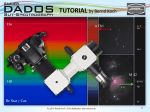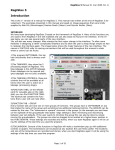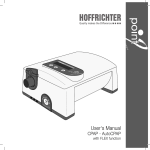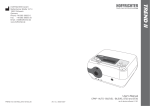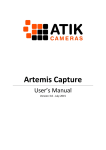Download SAC4-2 - Opticstar
Transcript
SAC4-2 Please do not plug your camera in until you load the software Thank you for your purchase of the SAC4 astronomical imaging camera. With some practice and patience you will be imaging many planetary, lunar, and other solar system objects... Please take the time to read these instructions and install the software in the order laid out below. Enjoy, and please e-mail us an image. The SAC4 we believe is the future of astronomical imaging of planetary objects SAC 4 User Manual Errors and Omissions A newer and better version of these instructions will be available online very soon. Revision 1.0 SAC4 User Manual Table of Content Page SAC8 1 1. Parts list 3 2. Software installation 3 3. Overview 3 4. Introduction 3 5 Getting started 6. Integration 4 7. Frames, Images and Stacking 4 8. Dark frames 5 9. Autoguiding 5 10. Drift imaging 6 11. Configuring AstroVideo 6 11.1. File..Save as 16-bit FITS file 7 11.2 File..Save as BMP image file 7 11.3. File..Save as JPG image file 7 11.4. Toolbar command (View menu) 8 11.5. Status Bar command (View menu) 8 11.6. Status Bar command (View menu) 8 11.7. View..Video Preview 8 11.8. View..Contrast Adjust 8 12. Cleaning and Maintenance 12 13. Support and Warranty 12 13.13. SAC 4 Limited Warranty 12 13.14. RGA Number Required 12 13.15. Contacting Technical Support 12 Page 2 of 14 Rev. 1.0 SAC4 User Manual 1. Parts list 1. Camera with T ring and removable T to 1.25 adapter 2. CDROM 2. Software installation Please “DRIVER” folder and click on “SETUP. EXE”. This will install the driver. Please note where driver is installed. Then click on “SAC AV244 and self install this program. Then plug your camera into a USB2.0 socket and when the wizard wants the driver either let it do it automatically or if it fails to find the driver then point the wizard to the driver previously loaded. 3. Overview For using the SAC4, Astrovideo will be used. This program will control all the cameras functions and output as a Fits, bitmap or Jpeg image. Also slow frame rate AVI’s may be captured. Picture Window is a 30-day trial version as is Photo Impact 5. The reason for this is to keep cost down. Most people have a program or two already on their computer for mulnipulation images. If you feel conformable with the program(s) you have by all means use them. But we encourage you to try Picture Window, as it is a very powerful program capable of mulnipualating your images down to the pixel level. It is an involved program so we also inclose Photo Impact 5 trail. This program is very simple and will get you used to image processing before moving on to Picture Window. Picture Window can be purchased by its creators who are listed in the support section. It is reasonably priced at $49.00. We do not recommend buying PhotoImact5 as it is not a really powerful image processor. Image process is an important part of your imaging process. Your raw images from the camera may not look as good as you expect but with a little practice you can turn them in to a great image. Don’t get discouraged, the complete image process involves taking the image, dark frame, dark frame subtraction, flat fields, and processing. The Astrovideo program that you will use to image with can do a lot of this automatically. To familiar yourself with the controls and the camera it is best to image in the daytime. Image an object that does not move in the wind, as this will bring the image in and out of focus. Speaking of focusing this will be the hardest thing to get down pat. Focus must be exact with a CCD chip, unlike the eye, which can have a slightly off focus and still give you a sharp look. It is best to focus an object in a 10mm eyepiece, and then exchange the eyepiece for the camera. The camera at prime focus images and focuses very close to what a 610-mm eyepiece does. 4. Introduction Astrovideo is a video image capture program with a number of revolutionary features. Page 3 of 14 Rev. 1.0 SAC4 User Manual It runs on a PC with a USB 2.0 port and extends the utility of video imaging into new areas, which were previously thought to be impossible for video. Add to this that the SAC4’s sensitivity and large format, a whole new field of video imaging is now open. There are a number of aspects in which astronomical imaging is more demanding than conventional imaging. Frequently, the objects are very faint and even those that are bright (planets, the Moon) are constantly moving. Even with quality telescope mounts, the objects may not keep perfectly still in the field of view. Astrovideo addresses all of these problems and solves them. A user forum is available online at the SAC yahoo http://groups.yahoo.com/group/SACimaging/?yguid=100851834 5. group at Getting started This is assuming drivers and Astrovideo has been installed correctly. First select camera type under file as SAC4-2 or SAC4 new. Then under driver the SAC4 will be the only driver. As soon as you select the driver a video window will open. It is defaulted at 640x480. This will save computer processing power. The bigger the image the more demand on your processor it will be. Image size can be controlled under “video, video format”. Exposure time, red-green and blue gain, and sensitivity can be found under “video, video source”. It will be best to try during the daytime first. Exposure will be needed to be knocked down a lot because of the light but this will give you practice on the hardest thing with CCD cameras and that is FOCUSING. It is very easy to miss focus. At F-10 and above it can be a challenge but with a little practice it will come easy. You will find that once you are close to focus very little movement of the focus knob of your scope will make big changes in focus. An electronic motor on focus and the large focus wheels available on the market help make this easier. Once you have mastered daytime imaging then it times to move to nighttime. It may help to try a distant light source before moving to objects in the sky. Once you are ready use a 4-6 mm eyepiece to center and bring to focus the moon (this should be your 1st object because of it’s ease.) Replace the eyepiece with the camera and slowly focus again. You will need to reduce the exposure time if you only get white light. Try 1-10 MS (milliseconds, 1/1000 of a second) and you may need to bring down each colors gain controls too. Use low sensitivity only. The more sensitive you set the camera at the more noise you end up with. You will have to experiment with color setting, exposure time, gain, etc. Each set up is different. Once you start getting the hang of things you may want to boost your F ratio up with a Barlow lens. If you are using a Schmidt-Cassegrain scope it will be at F-10. With a 2x Barlow you will be at F-20 and have larger images but light level will be less. You should be able to go to F-30 (a 3x Barlow) under ideal conditions. Many things affect your imaging. Clarity of sky, tubluance in the atmosphere, heat rising from the house you are pointed over, proper focus. Imaging is not an exact since but an art form at times. 6. Integration For more information on this feature please refer to Astrovideo’s help files. 7. Frames, Images and Stacking Page 4 of 14 Rev. 1.0 SAC4 User Manual Astrovideo can make very long integration’s if necessary. However, telescope mounts are seldom sufficiently precise to keep the subject perfectly stable over long exposure times. To cope with this situation, Astrovideo can be configured to capture a large number of separate images, each one the integration of many video frames. The number of frames in each image is limited by the performance of the telescope mount. If it tracks very well, then there can be many frames in each image. If the tracking is less precise, then it is better to capture fewer frames in each image and to save a larger number of images. The number of frames in each image should be set to the largest number that does not cause the stars to trail. Once a set of images is obtained, AstroVideo helps you to add them together to achieve a final result equivalent to a much longer exposure. Since the telescope mount is imperfect, each image, although essentially of the same scene, will be centered on a slightly different point. AstroVideo offers a number of methods of registering the images to coincide in order to achieve a crisp result. Manual alignment involves identifying a common feature in each image so that AstroVideo can bring them all into alignment. Automatic alignment is performed by the program searching the images for best match. It works best with images containing plenty of detail and in which the misalignment is not too severe. Otherwise the search times become very long and the manual method is quicker. AstroVideo also offers an inbetween method in which the reference stars are identified manually but the precise centering of the star is automatically refined before stacking. Image combining tools If automatic combining works well, try the option to add images automatically at capture time. Each successive image in a capture set is brought into registration with the first image and added to a composite image. This can be used to produce a single image over an effective exposure time that is greater than the mount stability would otherwise allow. Again more information is available in Astrovideos help files. 8. Dark frames Images obtained from video cameras under very low signal conditions are usually replete with instrumental artifacts. These include brighter areas, stripes and bright or dark individual pixels. Much of this distraction can be removed by numerical subtraction of a dark image from each light image. The dark image is taken under the same conditions as the light image (exposure time, temperature, etc.) except that the camera is covered to prevent the light entering. AstroVideo allow you to designate any image as a dark frame and can automatically subtract the dark frame from each image either before displaying or before saving it to file. Even if neither of these options is employed, AstroVideo has an off-line dark subtraction tool allowing dark images to be subtracted from light images after the event. Dark menu options 9. Autoguiding Unlike an astronomical video camera, AstroVideo sees images from the SAC4 in near real-time. It can therefore check for mis-tracking of the telescope mount and can determine what guiding adjustments need to be made. If the system is used with a mount which recognizes the proprietary Meade LX-200™ protocol, AstroVideo can send guiding instructions to the mount in order to improve the tracking. This can be done as part of a video image capture process or it can be done as an auxiliary Page 5 of 14 Rev. 1.0 SAC4 User Manual function to separate CCD imaging. In this way, a low cost video camera becomes an effective autoguider. Autoguiding menu options. Astrovideo will now track most mounts. Please see Astrovideo’s help files for more details. Again more information is available in Astrovideos help files. 10. Drift imaging A revolutionary feature of AstroVideo is its ability to capture astronomical images even without a driven telescope mount. Using a telescope or a conventional lens with the SAC4 on a fixed mounting normally produces a trailed image. During the exposure time, the rotation of the Earth causes the stars to move across the field of view and to trail the image. Although such star trails can be visually pleasing, they are not a substitute for sharp images. AstroVideo can be configured to perform the image integration with progressive displacement so keep in step with the sidereal motion. Used in this way, there is no question of tracking errors, provided the camera/telescope is stable. Indeed the movement of the sky is perfect in its smooth progress which AstroVideo follows. The exposure time with this method is effectively unlimited but the exposure which any individual star or other object receives is simply the total transit time across the field of view. The effective exposure time, regardless of the actual imaging time, using drift imaging is therefore dependant on the size of the field of view of the system. This in turn depends on the size of the chip and the focal length of the optical system (lens or telescope). The following table shows the maximum effective exposure time on the celestial equator, using a typical 5mm video camera chip for a range of camera and telescope focal lengths. fl (mm) 28 50 58 125 200 350 882 906 1500 2260 minutes 40,82 22,90 19,74 9,17 5,73 3,27 1,30 1,26 0,76 0,51 It is clear that for focal lengths greater than those of a telephoto camera lens, the effective exposure time becomes too short for deep sky imaging at least close to the celestial equator. Imaging closer to the poles gives a 1/Cosine (declination) increase in the effective exposure time which may be exploited. Again more information is available in Astrovideos help files. 11. Configuring AstroVideo Page 6 of 14 Rev. 1.0 SAC4 User Manual AstroVideo provides a number of advanced features, some of which need correct configuration in order to achieve the desired result. General setting up of the capturing process is done by selecting Capture...Setup. Choices include how many frames are integrated into each image and how many images are to be captured, the image file names and the image file directory, display of images as they are captured, and display contrast options. To set up the use of dark frames select one or more of the pull-down options under the Dark menu bar option. To set up autoguiding click on Autoguiding...Setup. Options include the port number for serial commands, the image orientation and selection of the impulse time for guiding adjustments. To set up the parameters for drift imaging select Drift...Setup. You can either enter the parameters by hand or you can let AstroVideo determine the parameters from a pair of time spaced images. Again more information is available in Astrovideos help files. 11.1. File..Save as 16-bit FITS file This option saves the current image as a 16-bit FITS file. AstroVideo saves captured images in the 32-bit FITS format. Not all FITS viewing programs can handle this format. Accordingly, this option allows you to export the current image (the last one captured or the result of the last image combination) in 16-bit format which is more generally supported. If the brightest pixel in the image can be fitted directly into 16-bits, then a file dialog appears to allow the destination file to be specified. If the image contains pixel values that are too large to fit into 16 bits, a dialog appears. AstroVideo offers you the choice of saturating the overloaded pixels (the better option if there are just a few pixels affected) or of scaling the whole image to fit into 16 bits. In the latter case, the scale factor offered is that necessary to fit within 16 bits. If you want to preserve relative pixel magnitudes between several images, you will need to settle on a fixed scale factor which is used for all the members of the set and which accommodates the brightest pixels in all the images. 11.2. File..Save as BMP image file This option saves the current image as a BMP format image file. A file dialog appears inviting you to specify the file name to be used. The file will be a monochrome or colour BMP file depending on the settings in the Capture...Setup dialog. Note that the dynamic range of a BMP file is only 8 bits (256 levels) in each colour which is considerably inferior to the dynamic range of the FITS format files used by AstroVideo by default. 11.3. File..Save as JPG image file This option saves the current image as a JPG format image file. Page 7 of 14 Rev. 1.0 SAC4 User Manual A file dialog appears inviting you to specify the file name to be used. The file will be a monochrome. Note that the dynamic range of a JPG file is only 8 bits (256 levels) in each colour which is considerably inferior to the dynamic range of the FITS format files used by AstroVideo by default. The JPG compression is also not conservative which means that there is some loss of detail in the compressed image. The attraction of this format is that the file size is very muToolbar command (View menu) Use this command to display and hide the Toolbar, which includes buttons for some of the most common commands in AstroVideo, such as File Open. A check mark appears next to the menu item when the Toolbar is displayed. 11.4. Toolbar command (View menu) Use this command to display and hide the Toolbar, which includes buttons for some of the most common commands in AstroVideo, such as File Open. A check mark appears next to the menu item when the Toolbar is displayed. 11.5. Status Bar command (View menu) Use this command to display and hide the Status Bar, which describes the action to be executed by the selected menu item or depressed toolbar button, and keyboard latch state. A check mark appears next to the menu item when the Status Bar is displayed. 11.6. Status Bar command (View menu) Use this command to display and hide the Status Bar, which describes the action to be executed by the selected menu item or depressed toolbar button, and keyboard latch state. A check mark appears next to the menu item when the Status Bar is displayed. 11.7. View..Video Preview This option displays the current video signal in Preview mode in the left half of the window. Preview mode is processor intensive; for this reason, AstroVideo uses preview mode at 4Hz refresh rate. If no driver is connected, the option is disabled. 11.8. View...Contrast Adjust This option displays a dialog in which the displayed image contrast can be adjusted. This is especially useful if you plan to export an image in BMP or JPG format without further image processing. Page 8 of 14 Rev. 1.0 SAC4 User Manual 11.9. Troubleshooting If you do not see any change of image characteristics when experimenting with extended exposure operation, then you may have selected the wrong parallel port. Some PCs use different port addresses for the parallel ports so it may be worth trying the other options. If, after an extended exposure image, you see only a blank frame, when there is reason to suppose that there should be something showing, then one of two things is happening. Either AstroVideo is capturing a black frame because the video driver has not yet delivered the new integrated frame. Or AstroVideo has missed the new integrated frame and has captured a following normal (non-integrated) frame. The latter is dim but not completely black, depending on the conditions of the experiment. If your processor is heavily loaded or under-researched, the driver may be slower than normal in preparing the integrated frame for delivery. In that case, try increasing the post-exposure time in steps of 10mS to see if the integrated frame can be reliably delivered If the integrated image is still black, you may not have remembered to set the contrast to maximum in the Video source dialog. Of course, you may have the lens cap on. If the integrated image is showing signs of saturation, you may be integrating for too long or you may have the brightness setting too high (mid point is usually suitable). 11.10. Dark frames Dark frames can be used with extended exposure operation in the usual way. You can use a single image (monochrome or colour) as the dark frame for integration by capturing it and then defining it as the dark frame using the menu item Dark...Current image image. If necessary, you can capture many dark images and add them together (Tools...Combine...Fixed) and then define the resulting file(s) to be the dark frame using Dark...Use from file. You will have to combine the colour separations separately if you have specified colour images. Remember to scale the dark frame (Dark...Scale darkframe) if the resulting summed dark image corresponds to an exposure time different from that of the frames to be captured. If you have defined colour images in Capture...Setup, you will be prompted for the file names of all three colour separations of the dark frame. Remember to select dark subtraction for both image display and image saving if this is what you intend. 11.11. Dynamic range Page 9 of 14 Rev. 1.0 SAC4 User Manual The dynamic range of any one frame captured with extended exposure times, is still just 256 levels. This is rather inadequate for astronomical imaging where the subject dynamic range may be much greater than this. If dark subtraction is in use, the dynamic range is even more restricted. Accordingly, to get the best possible image results, it is usually better to use AstroVideo to add a number of shorter exposure time images into a single final image, than to make just one frame equal to one image with the total exposure time desired. This approach also means that saturation of bright areas is more readily avoided. With the option to use extended exposure times, there are two ways to produce a final image which represents the desired total exposure time. One is to make the required number of frames integrate into a single image. The other is to make the required number of single frame images into a final composite image using either post capture combining or using the add-during-capture option. This latter option allows you automatically to register successive images and add them into the final composite image, which can be of almost unlimited exposure time. As you get more skilled at making images with the SAC4 you may have questions about how the CCD performs with your system or how much sky you can cover with one image. This chapter is designed to answer some of these questions and lead you to resources to discover your own solutions to your unique issues related to CCD imaging. 11.12. Using Focal Reducers and Barlows If you’re new to CCD imaging but experienced at visual observing you might be wondering how you can change the “magnification” of images taken with the SAC4. Obviously for visual observation changing the image size is as simple as changing the eyepiece used, but since the SAC is most often used for prime focus photography with no eyepiece you may feel you are at the mercy of your optical focal length. The solution then is to change the focal length of your telescope optics using a device called a focal reducer. Many telescope manufacturers sell optional focal reducers that allow owners to alter the focal length of their optical system. For example, Meade sells two focal reducers, an f/6.3 and f/3.3 that can be used with their Schmidt-Cassegrain telescopes. To calculate what effect focal reducers have on the amount of sky covered we use the same formula as in the previous section, but plugging in the different focal length of the optical system using the focal reducer. For example, the following table shows the difference for a hypothetical 8-inch telescope used at f10 and f/6.3 with the SAC 7B: Focal Ratio Focal Length (mm) f/10 f/6.3 2032 1280 Horizontal coverage 6.06’ 9.62’ Vertical Coverage 4.54’ 7.21’ It is worth mentioning however that longer focal lengths result in dimmer images (due to the spreading out of light) than shorter focal lengths. Because of this, choosing the correct optical focal length then becomes a question of the size versus Page 10 of 14 Rev. 1.0 SAC4 User Manual the brightness of the object you want to image. For smaller, brighter objects such as planets you’ll probably want to use the longest focal length possible, but for larger objects such as nebulae you’ll probably wish to select a shorter focal length. Experimentation is the best way to get a feel for the properties of your optics and the SAC4 camera. The exact opposite happens with barlows. A 2x Barlow will give F-20 with the same setup. As a 2.5 will give F-25, a 1.5 will give F-15 and so on. Page 11 of 14 Rev. 1.0 SAC4 User Manual 12. Cleaning and Maintenance The SAC4 requires little user maintenance and should be treated like you would treat any optical instrument. To clean the CCD chip on the SAC4 use the same method you use for cleaning your telescope optics. For objects that do not blow off, the use of a “lens pen” (also available at camera shops) is ideal. If you do not have a lens pen, you can use a small amount of lens cleaning solution on a Q-Tip to gently remove the object. Remember to unplug your camera from the computer when not in use since the fan will still be operating as long as it’s plugged in. For the SAC4 be sure to disconnect the power supply since leaving the thermo-electric cooling running will lead to premature failure. 13. Support and Warranty 13.13. SAC4 Limited Warranty The SAC4 is warranted by SAC Imaging (“SAC”) to be free of defects in materials and workmanship for a period of ONE YEAR from the date of original purchase. SAC will repair or replace a product, or part thereof, found by SAC to be defective, provided that the defective part is returned to SAC, pre-paid, with proof of purchase. This warranty applies to the original purchaser only and is non-transferable. 13.14. RGA Number Required Prior to the return of any product or part, a Return Goods Authorization (RGA) number must be obtained by writing or calling (321) 259-6498. Each part returned should contain a written statement detailing the nature of the claimed defect, as well as the owner’s name, address and telephone number. This warranty is not valid in cases where the product has been abused or mishandled, where unauthorized repairs have been attempted or performed, or where depreciation of the product is due to normal wear and tear. SAC specifically disclaims special, indirect, or consequential damages or lost profit which may result from breach of this warranty. Any implied warranties which cannot be disclaimed are hereby limited to a term of one year from the date of original purchase. This warranty gives you specific rights. You may have other rights which vary from state to state. SAC reserves the right to change product specifications or to discontinue products without notice. 13.15. Contacting Technical Support Page 12 of 14 Rev. 1.0 SAC4 User Manual For technical support for the SAC 4 cameras, drivers or AstroVideo software: SAC Imaging P.O. Box 360982 Melbourne, Fl. 32936 (321) 259-6498 Email: [email protected] Picture Window For Picture Window support, visit the Picture Window web site at www.dl-c.com Page 13 of 14 Rev. 1.0 SAC4 User Manual NOTES Page 14 of 14 Rev. 1.0
















